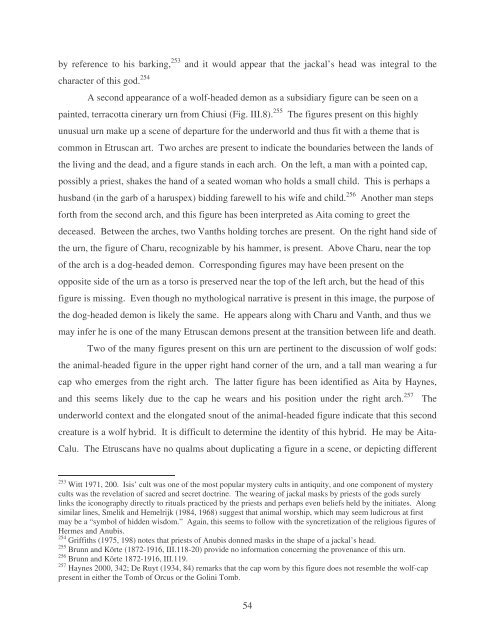Final Draft - Preview Matter - Florida State University
Final Draft - Preview Matter - Florida State University
Final Draft - Preview Matter - Florida State University
You also want an ePaper? Increase the reach of your titles
YUMPU automatically turns print PDFs into web optimized ePapers that Google loves.
y reference to his barking, 253 and it would appear that the jackal’s head was integral to the<br />
character of this god. 254<br />
A second appearance of a wolf-headed demon as a subsidiary figure can be seen on a<br />
painted, terracotta cinerary urn from Chiusi (Fig. III.8). 255 The figures present on this highly<br />
unusual urn make up a scene of departure for the underworld and thus fit with a theme that is<br />
common in Etruscan art. Two arches are present to indicate the boundaries between the lands of<br />
the living and the dead, and a figure stands in each arch. On the left, a man with a pointed cap,<br />
possibly a priest, shakes the hand of a seated woman who holds a small child. This is perhaps a<br />
husband (in the garb of a haruspex) bidding farewell to his wife and child. 256 Another man steps<br />
forth from the second arch, and this figure has been interpreted as Aita coming to greet the<br />
deceased. Between the arches, two Vanths holding torches are present. On the right hand side of<br />
the urn, the figure of Charu, recognizable by his hammer, is present. Above Charu, near the top<br />
of the arch is a dog-headed demon. Corresponding figures may have been present on the<br />
opposite side of the urn as a torso is preserved near the top of the left arch, but the head of this<br />
figure is missing. Even though no mythological narrative is present in this image, the purpose of<br />
the dog-headed demon is likely the same. He appears along with Charu and Vanth, and thus we<br />
may infer he is one of the many Etruscan demons present at the transition between life and death.<br />
Two of the many figures present on this urn are pertinent to the discussion of wolf gods:<br />
the animal-headed figure in the upper right hand corner of the urn, and a tall man wearing a fur<br />
cap who emerges from the right arch. The latter figure has been identified as Aita by Haynes,<br />
and this seems likely due to the cap he wears and his position under the right arch. 257 The<br />
underworld context and the elongated snout of the animal-headed figure indicate that this second<br />
creature is a wolf hybrid. It is difficult to determine the identity of this hybrid. He may be Aita-<br />
Calu. The Etruscans have no qualms about duplicating a figure in a scene, or depicting different<br />
253<br />
Witt 1971, 200. Isis’ cult was one of the most popular mystery cults in antiquity, and one component of mystery<br />
cults was the revelation of sacred and secret doctrine. The wearing of jackal masks by priests of the gods surely<br />
links the iconography directly to rituals practiced by the priests and perhaps even beliefs held by the initiates. Along<br />
similar lines, Smelik and Hemelrijk (1984, 1968) suggest that animal worship, which may seem ludicrous at first<br />
may be a “symbol of hidden wisdom.” Again, this seems to follow with the syncretization of the religious figures of<br />
Hermes and Anubis.<br />
254<br />
Griffiths (1975, 198) notes that priests of Anubis donned masks in the shape of a jackal’s head.<br />
255<br />
Brunn and Körte (1872-1916, III.118-20) provide no information concerning the provenance of this urn.<br />
256<br />
Brunn and Körte 1872-1916, III.119.<br />
257<br />
Haynes 2000, 342; De Ruyt (1934, 84) remarks that the cap worn by this figure does not resemble the wolf-cap<br />
present in either the Tomb of Orcus or the Golini Tomb.<br />
54

















